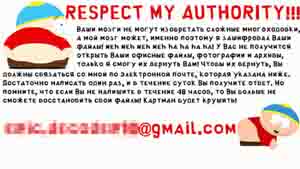RANSOM_CRYPICH.EL
Windows


Threat Type: Trojan
Destructiveness: No
Encrypted: Yes
In the wild: Yes
OVERVIEW
Spammed via email, Downloaded from the Internet, Dropped by other malware
This Trojan arrives as an attachment to email messages spammed by other malware/grayware or malicious users. It arrives on a system as a file dropped by other malware or as a file downloaded unknowingly by users when visiting malicious sites.
It connects to certain websites to send and receive information.
TECHNICAL DETAILS
494,080 bytes
EXE
No
28 Aug 2015
Connects to URLs/IPs, Encrypts files, Drops files
Arrival Details
This Trojan arrives as an attachment to email messages spammed by other malware/grayware or malicious users.
It arrives on a system as a file dropped by other malware or as a file downloaded unknowingly by users when visiting malicious sites.
Installation
This Trojan drops the following copies of itself into the affected system and executes them:
- %Program Files%\1C\{malware file name}.exe
- %User Temp%\1C\{malware file name}.exe
(Note: %Program Files% is the Program Files folder, where it usually is C:\Program Files on all Windows operating system versions; C:\Program Files (x86) for 32-bit applications running on Windows 64-bit operating systems.. %User Temp% is the user's temporary folder, where it usually is C:\Documents and Settings\{user name}\Local Settings\Temp on Windows 2000, Windows Server 2003, and Windows XP (32- and 64-bit); C:\Users\{user name}\AppData\Local\Temp on Windows Vista (32- and 64-bit), Windows 7 (32- and 64-bit), Windows 8 (32- and 64-bit), Windows 8.1 (32- and 64-bit), Windows Server 2008, and Windows Server 2012.)
It drops the following component file(s):
- %User Temp%\1C\desk.jpg
- %Program Files%\1C\{random file name}.{random extension} - contains victim ID and time stamp
- %User Temp%\1C\desk.bmp - ransom note image
- %User Temp%\1C\desk.jpg - ransom note image
(Note: %User Temp% is the user's temporary folder, where it usually is C:\Documents and Settings\{user name}\Local Settings\Temp on Windows 2000, Windows Server 2003, and Windows XP (32- and 64-bit); C:\Users\{user name}\AppData\Local\Temp on Windows Vista (32- and 64-bit), Windows 7 (32- and 64-bit), Windows 8 (32- and 64-bit), Windows 8.1 (32- and 64-bit), Windows Server 2008, and Windows Server 2012.. %Program Files% is the Program Files folder, where it usually is C:\Program Files on all Windows operating system versions; C:\Program Files (x86) for 32-bit applications running on Windows 64-bit operating systems.)
It creates the following folders:
- %Program Files%\1C
- %User Temp%\1C
(Note: %Program Files% is the Program Files folder, where it usually is C:\Program Files on all Windows operating system versions; C:\Program Files (x86) for 32-bit applications running on Windows 64-bit operating systems.. %User Temp% is the user's temporary folder, where it usually is C:\Documents and Settings\{user name}\Local Settings\Temp on Windows 2000, Windows Server 2003, and Windows XP (32- and 64-bit); C:\Users\{user name}\AppData\Local\Temp on Windows Vista (32- and 64-bit), Windows 7 (32- and 64-bit), Windows 8 (32- and 64-bit), Windows 8.1 (32- and 64-bit), Windows Server 2008, and Windows Server 2012.)
Autostart Technique
This Trojan adds the following registry entries to enable its automatic execution at every system startup:
HKEY_LOCAL_MACHINE\SOFTWARE\Microsoft\
CurrentVersion\Run
pr = "%Program Files%\1C\{malware file name}.exe"
Other System Modifications
This Trojan changes the desktop wallpaper by modifying the following registry entries:
HKEY_CURRENT_USER\Control Panel\Desktop
TileWallpaper = "0"
(Note: The default value data of the said registry entry is {user-defined}.)
HKEY_CURRENT_USER\Control Panel\Desktop
Wallpaper = "%User Temp%\desk.bmp"
(Note: The default value data of the said registry entry is {user-defined}.)
It sets the system's desktop wallpaper to the following image:
Other Details
This Trojan connects to the following website to send and receive information:
- http://{BLOCKED}-update.com/install/inst.php?vers=CL%201.1.0.0&id={victim ID}-{time stamp}{random number}&sender=eric
It encrypts files with the following extensions:
- dt
- ods
- pef
- pptm
- txt
- pst
- ptx
- pz3
- odp
- qic
- wps
- r3d
- rwl
- rx2
- p12
- sbs
- wps
- odc
- odb
- old
- nbd
- nx1
- nrw
- orf
- ppt
- csv
- mdb
- cer
- arj
- ods
- odt
- docx
- gzip
- m2v
- cpt
- raw
- cdr
- 3gp
- 7z
- rar
- db3
- zip
- xls
- rtf
- doc
- jpeg
- jpg
- dbf
- 1cd
- xlsx
- pptx
- ppsx
- key
- wab
- pwm
- tib
- dwg
- xlsb
- xlsk
- xlsm
- 113
- accdb
- asm
- bak
- fbx
- fbw
- fbk
- fdb
- fbf
- max
- m3d
- ldf
- keystore
- gbk
- gho
- sn1
- sna
- spf
- sr2
- srf
- srw
- tis
- tbl
- x3f
It renames encrypted files using the following names:
- email-{BLOCKED}ecoder10@gmail.com.ver-CL 1.1.0.0.id-{victim ID}-{time stamp}{random number}.randomname-{encoded file name}.cbf
SOLUTION
9.750
Step 1
Before doing any scans, Windows XP, Windows Vista, and Windows 7 users must disable System Restore to allow full scanning of their computers.
Step 2
Note that not all files, folders, and registry keys and entries are installed on your computer during this malware's/spyware's/grayware's execution. This may be due to incomplete installation or other operating system conditions. If you do not find the same files/folders/registry information, please proceed to the next step.
Step 3
Delete this registry value
Important: Editing the Windows Registry incorrectly can lead to irreversible system malfunction. Please do this step only if you know how or you can ask assistance from your system administrator. Else, check this Microsoft article first before modifying your computer's registry.
- In HKEY_LOCAL_MACHINE\SOFTWARE\Microsoft\CurrentVersion\Run
- pr = "%Program Files%\1C\{malware file name}.exe"
- pr = "%Program Files%\1C\{malware file name}.exe"
Step 4
Reset your Desktop properties
Step 5
Search and delete these folders
- %Program Files%\1C
- %User Temp%\1C
Step 6
Scan your computer with your Trend Micro product to delete files detected as RANSOM_CRYPICH.EL. If the detected files have already been cleaned, deleted, or quarantined by your Trend Micro product, no further step is required. You may opt to simply delete the quarantined files. Please check this Knowledge Base page for more information.
Did this description help? Tell us how we did.


